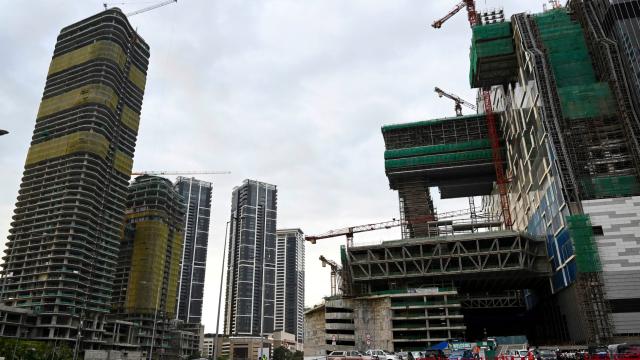Carbon emissions from buildings reached an all-time high, according to a new United Nations report. In 2019, buildings were responsible for 9.95 gigatons of carbon — up from 9.7 gigatons in 2018 — accounting for 38% of the world’s output of the planet-warming gas.
The report, put out by the UN Global Alliance for Buildings and Construction on Wednesday, shows the world has a long ways to go to clean up pollution tied to buildings. But it also includes a roadmap for how to get there through a “triple strategy.”
There were a few big factors that drove this year’s increase. The first is that while a growing number of homes and other buildings moved away from directly using coal, wood, and oil for heating and cooking, they instead hooked up to electricity grids powered by fossil fuels. In many cases, that resulted in an increase in emissions, revealing that decarbonisation through electrification only works if the grid itself runs on clean energy.
But it wasn’t just that buildings ran on fossil fuels; they also burned more than they needed to. The report found that the other big reason for the uptick in emissions was increased use of energy in buildings, especially for heating and cooling.
The sector also constructed more buildings in 2019, and the materials most-often used to build, including cement and steel, are often carbon-intensive to produce.
“Building design and type, such as high-rise towers, have resulted in increased demand for steel and cement,” Martina Otto, head of secretariat of the Global Alliance for Buildings and Construction who worked on the report, said in an email.
This also added to the overall increase in emissions. In the long-term, though, Otto said these strong materials could give the structures more lasting power, which in theory would mean we don’t have to build as much in the future.
World leaders did take some steps to decarbonise the buildings sector. In 2019, funding to boost energy efficiency in buildings increased for the first time in three years. The world spent $US152 ($202) billion on these projects in 2019, which is an increase of 3% from 2018. Yet none of these efforts were nearly enough to bend the curve of building global greenhouse gas pollution. Investments in energy efficient buildings still made up only a small proportion of the $US5.8 ($8) trillion the world spent in the building and construction sector, and was still outpaced by those poured into conventional buildings and construction by a ratio of $US1 ($1) to $US37 ($49).
Of course, inefficiency wouldn’t be such a huge problem if the world was powered by carbon-free sources, but the world didn’t put nearly enough effort into decarbonising electricity last year. On the contrary, the world saw record-breaking expansion of natural gas infrastructure, which made it the number one contributor to 2019’s increase in carbon emissions. That has in part swamped efforts to decarbonise buildings.
“The index finds that annual decarbonisation progress is slowing down and has, in fact, almost halved from 2016 to 2019,” the report says. “While the number of building sector CO2 emissions reduction actions are growing, the rate of annual improvement is decreasing.”
There’s a lot the buildings sector can do to draw down its emissions. And in fact, leaders must make dramatic changes to the sector. To reach net-zero carbon emissions by 2050 and meet the goals of the Paris Agreement, the report says that the entire sector will have to increase its decarbonisation efforts by a factor of 5.
“To drive down energy demand and emissions, we need a triple strategy that combines the aggressive reduction of energy demand in the built environment while decarbonising the power sector and implementing materials strategies that reduce lifecycle carbon emissions,” Otto said.
These efforts could make a huge difference in the fight to curb climate change and improve people’s lives in other ways. In 2018, for instance, the UN Development Program found that 1.8 billion people lived in inadequate housing, including slums and informal and/or overcrowded settlements. The world’s poor are also far more likely to live in poorly ventilated, energy inefficient buildings, where they are subject to air pollution, extreme heat and cold, and high energy bills. These injustices have become glaring amid covid-19 lockdowns, when we’re all spending so much more time in our homes.
But the need to invest in decarbonising the housing sector presents an opportunity to take on these challenges. Electrifying buildings and improving efficiency could create jobs, which are much needed during our current global unemployment crisis. A 2020 International Energy Agency report found that we could create up to 30 permanent jobs in manufacturing and construction for every $US1 ($1.4) million dollars invested in retrofits or efficient building. Improving efficiency would also cut down on utility bills, which could help poor families that spend a disproportionate amount of their income on them. Pandemic-related economic stimulus bills represent a clear avenue to do this and ensure the future is more just.
“In the U.S. alone, we spend trillions of dollars each year investing in our homes, offices, schools, and the rest of the built environment,” Billy Fleming, the director of the University of Pennsylvania’s McHarg Centre in the Weitzman School of Design who did not work on the report, wrote in an email. “Every dollar we invest in our communities that isn’t driving rapid decarbonisation, putting building and trades union members to work, and making real, tangible improvements in people’s lives is worse than a waste — it’s a vector spreading climate crises and all manner of injustice around the world.”
